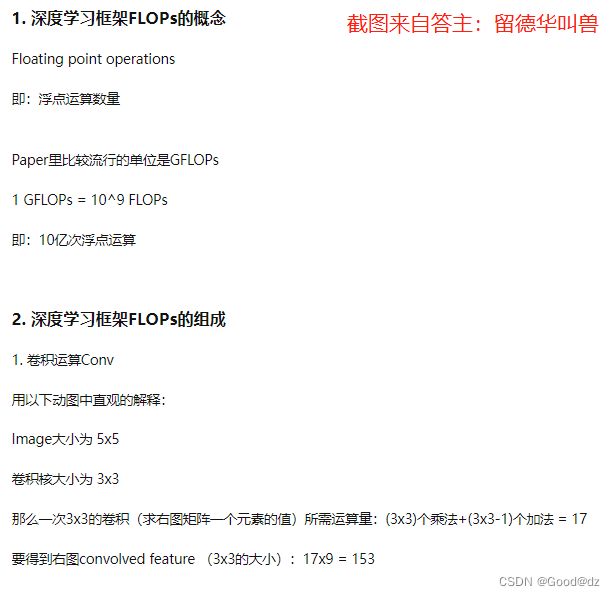RESA车道线检测算法---计算量和参数量的计算
FLOPS 基础概念理解
FLOPS:注意全大写,是floating point operations per second的缩写,意指每秒浮点运算次数,理解为计算速度。是一个衡量硬件性能的指标。
FLOPs:注意s小写,是floating point operations的缩写(s表复数),意指浮点运算数,理解为计算量。可以用来衡量算法/模型的复杂度。

深度学习框架 FLOPs 的组成:卷积、反卷积、激活函数、linear、BatchNorm、Upsample、Poolings等。其中,Conv所占的比重通常最大和预处理之后网络的输入图像大小有关系而 #Parameters和图像大小无关。
安转thop
pip install thop
简单案例
from torchvision.models import resnet50
from thop import profile
model = resnet50()
input = torch.randn(1, 3, 224, 224)
macs, params = profile(model, inputs=(input, ))
macs, params = clever_format([macs, params], "%.3f")
print('MACs: {}'.format(macs))
print('Params: {}'.format(params))
参考resa复现来跑通源代码
在resa-main文件夹下,添加py文件,复制以下代码来计算网络的计算量和参数量:
import torch.nn.parallel
import torch.optim
import argparse
from utils.config import Config
import torch.nn as nn
import torch
import torch.nn.functional as F
from models.resnet import ResNetWrapper
from models.decoder import BUSD, PlainDecoder
class RESA(nn.Module):
def __init__(self, cfg):
super(RESA, self).__init__()
self.iter = cfg.resa.iter
chan = cfg.resa.input_channel
fea_stride = cfg.backbone.fea_stride
self.height = cfg.img_height // fea_stride
self.width = cfg.img_width // fea_stride
self.alpha = cfg.resa.alpha
conv_stride = cfg.resa.conv_stride
for i in range(self.iter):
conv_vert1 = nn.Conv2d(
chan, chan, (1, conv_stride),
padding=(0, conv_stride//2), groups=1, bias=False)
conv_vert2 = nn.Conv2d(
chan, chan, (1, conv_stride),
padding=(0, conv_stride//2), groups=1, bias=False)
setattr(self, 'conv_d'+str(i), conv_vert1)
setattr(self, 'conv_u'+str(i), conv_vert2)
conv_hori1 = nn.Conv2d(
chan, chan, (conv_stride, 1),
padding=(conv_stride//2, 0), groups=1, bias=False)
conv_hori2 = nn.Conv2d(
chan, chan, (conv_stride, 1),
padding=(conv_stride//2, 0), groups=1, bias=False)
setattr(self, 'conv_r'+str(i), conv_hori1)
setattr(self, 'conv_l'+str(i), conv_hori2)
idx_d = (torch.arange(self.height) + self.height //
2**(self.iter - i)) % self.height
setattr(self, 'idx_d'+str(i), idx_d)
idx_u = (torch.arange(self.height) - self.height //
2**(self.iter - i)) % self.height
setattr(self, 'idx_u'+str(i), idx_u)
idx_r = (torch.arange(self.width) + self.width //
2**(self.iter - i)) % self.width
setattr(self, 'idx_r'+str(i), idx_r)
idx_l = (torch.arange(self.width) - self.width //
2**(self.iter - i)) % self.width
setattr(self, 'idx_l'+str(i), idx_l)
def forward(self, x):
x = x.clone()
for direction in ['d', 'u']:
for i in range(self.iter):
conv = getattr(self, 'conv_' + direction + str(i))
idx = getattr(self, 'idx_' + direction + str(i))
x.add_(self.alpha * F.relu(conv(x[..., idx, :])))
for direction in ['r', 'l']:
for i in range(self.iter):
conv = getattr(self, 'conv_' + direction + str(i))
idx = getattr(self, 'idx_' + direction + str(i))
x.add_(self.alpha * F.relu(conv(x[..., idx])))
return x
class ExistHead(nn.Module):
def __init__(self, cfg=None):
super(ExistHead, self).__init__()
self.cfg = cfg
self.dropout = nn.Dropout2d(0.1) # ???
self.conv8 = nn.Conv2d(128, cfg.num_classes, 1)
stride = cfg.backbone.fea_stride * 2
self.fc9 = nn.Linear(
int(cfg.num_classes * cfg.img_width / stride * cfg.img_height / stride), 128)
self.fc10 = nn.Linear(128, cfg.num_classes-1)
def forward(self, x):
x = self.dropout(x)
x = self.conv8(x)
x = F.softmax(x, dim=1)
x = F.avg_pool2d(x, 2, stride=2, padding=0)
x = x.view(-1, x.numel() // x.shape[0])
x = self.fc9(x)
x = F.relu(x)
x = self.fc10(x)
x = torch.sigmoid(x)
return x
class RESANet(nn.Module):
def __init__(self, cfg):
super(RESANet, self).__init__()
self.cfg = cfg
self.backbone = ResNetWrapper(cfg)
self.resa = RESA(cfg)
self.decoder = eval(cfg.decoder)(cfg)
self.heads = ExistHead(cfg)
def forward(self, batch):
fea = self.backbone(batch)
fea = self.resa(fea)
seg = self.decoder(fea)
exist = self.heads(fea)
output = {'seg': seg, 'exist': exist}
return output
def parse_args():
parser = argparse.ArgumentParser(description='Train a detector')
parser.add_argument('config', help='train config file path')
parser.add_argument(
'--work_dirs', type=str, default='work_dirs',
help='work dirs')
parser.add_argument(
'--load_from', default=None,
help='the checkpoint file to resume from')
parser.add_argument(
'--finetune_from', default=None,
help='whether to finetune from the checkpoint')
parser.add_argument(
'--validate',
action='store_true',
help='whether to evaluate the checkpoint during training')
parser.add_argument(
'--view',
action='store_true',
help='whether to show visualization result')
parser.add_argument('--gpus', nargs='+', type=int, default='0')
parser.add_argument('--seed', type=int,
default=None, help='random seed')
args = parser.parse_args()
return args
if __name__ == '__main__':
args = parse_args()
cfg = Config.fromfile(args.config)
from thop import profile, clever_format
model = RESANet(cfg).cuda()
x = torch.zeros((1, 3, 368, 640)).cuda() + 1
macs, params = profile(model, inputs=(x,))
# macs, params = clever_format([macs, params], "%.3f")
# print('MACs: {}'.format(macs))
# print('Params: {}'.format(params))
name = 'disA'
print("%s | %s | %s" % ("Model", "Params(M)", "FLOPs(G)"))
print("---|---|---")
print("%s | %.2f | %.2f" % (name, params / (1000 ** 2), macs / (1000 ** 3)))
运行命令如下:
python main.py configs/tusimple.py
注释如果使用configs/culane.py,需要修改输入量x的维度,根据culane的img_height = 288和img_width = 800来修改
参考文献:
Pytorch中计算自己模型的FLOPs | thop.profile() 方法 | yolov5s 网络模型参数量、计算量统计